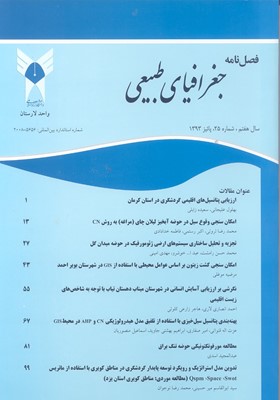تدوین مدل استراتژیک و رویکرد توسعه پایدار گردشگری در مناطق کویری با استفاده از ماتریس Swot ، Space ، Qspm (مطالعه موردی: مناطق کویری استان یزد)
محورهای موضوعی : اقلیم شناسیسید ابوالقاسم میر حسینی 1 , محمدرضا نوجوان 2
1 - استادیار، دانشگاه آزاداسلامی واحد میبد،گروه محیط زیست
2 - استادیار، دانشگاه آزاداسلامی واحد میبد،گروه ژئومورفولوژی
کلید واژه: یزد, رویکرد, مدل استراتژیک, ماتریس Space, مناطق کویری,
چکیده مقاله :
توریسم سیستم پیچیدهای است که ابعاد مختلف زندگی انسانی )اقتصادی، اجتماعی و فرهنگیزیست محیطی و کالبدی( را تحت تأثیر قرار میدهد. در این میان مناطق کویری به عنوان یکیاز مناطق اولویتدار برای توسعه اکوتوریسم در بسیاری از مناطق جهان مورد توجه قرار گرفتهاست. ایران با دارا بودن عرصههای کویری و بیابانی به عنوان یکی از مناطق دارای پتانسیل درزمینه توسعه اکوتوریسم بیابان و کویر مطرح است. اما هنوز استراتژیهای مشخصی نسبت بهتوسعه گردشگری در مناطق کویری تدوین نشده و مدل مشخصی وجود ندارد. لذا این مقاله بهدنبال پاسخگویی به این سوالات اساسی است که استراتژیهای اولویتدار جهت دستیابی بهتوسعه پایدار گردشگری در مناطق کویری استان یزد کدامند؟ مدل استراتژیک توسعه پایدارگردشگری در مناطق کویری چیست؟ به این سوالات از روش پیمایشی و روش برنامهریزیاستراتژیک استفاده شده است. نتایج پژوهش نشان داد که اولاً، گونه استراتژیهای توسعهگردشگری در مناطق کویری استان یزد در گروه استراتژیهای تدافعی قرار میگیرند؛ یعنیاستراتژیهایی که در راستای کاهش نقاط ضعف و از بین بردن تهدیدها تدوین شدهاند. ثانیاً،استراتژیهای مدیریتی نسبت به سایر استراتژیها در اولویت بالاتری قرار دارند. در پاسخ بهسوال دوم این نتیجه حاصل شد که اولویتدار بودن استراتژیهای مدیریتی به معنای نادیدهانگاشتن سایر استراتژیهای توسعه گردشگری نیست زیرا اجرای مجموعهای از سیاستها وراهبردها در مناطق کویری در پرتو اتخاذ رویکرد )مدل( یکپارچه برنامهریزی توسعه گردشگریامکانپذیر است.
Tourism is a complex system that affects various aspects of human life (economic, social, cultural, environmental and physical). In this regard, the desert areas have attracted attention of the world as preferred regions for ecotourism development. Iran, as a country enjoying vast desert areas, is considered as one of the regions with the potentials to develop ecotourism in desert areas In Iran, there have not been specific strategies towards the development of tourism in the desert and there is no specific model in this regard. Therefore, this study aims to answer these questions: What are the priority strategies to achieve sustainable tourism development in Yazd desert areas? And what is the strategic model for sustainable tourism development in the desert areas of Yazd province. To answer these questions, the survey and strategic planning methods were used. The results of the study showed that tourism development strategies in the desert regions of Yazd province are in the defensive strategies group, that is, the strategies that are developed to reduce and eliminate weaknesses and threats. Moreover, management strategies have a higher priority over other strategies. In answer to the second question, it was found out that priority of management strategies over other strategies mean that other strategies for tourism development in desert regions are ignored because adopting a series of policies and strategies in the desert is possible in the light of an integrated tourism approach (Model) to tourism development plan.
1- زراعتی و بیشمی (1386): برنامهریزی جهانگردی پایدار، مجله مسافران، شماره 39.
2- لومسدن، لس (1388): بازاریابی گردشگری، ترجمه ابراهیم گوهریان، انتشارات امیرکبیر.
_||_3- Bannon, J. (1976): Leisure Resources: its Comprehensive Planning, Englewood Cliffs, NJ: Prentice-Hall.
4- Chhabra, D. and Phillips, R. (2009): Tourism-Based Development, in Phillips, R. and Pittman, R. H., an Introduction to Community Development, Routledge.
5- Fennell, D. A. (2006): Ecotourism: an Introduction, Routledge.
6- Gunn, C. (2005): tourism planning: basics, concepts and cases, Taylor and Francis press.
7- Hall, C.M. (2000): Tourism Planning: Policies, Processes and Relationships, Prentice Hall.
8- Hall,C. M. and Page, S. J. (2002): the Geography of Tourism and Recreation: Environmental, Place and Space, Routledge.
9- Kaiser, E., Godschalk, D., and Chapin, F. (1995): Urban land Use planning, University of Illinois Press.
10- Kishore Sh., McHarry, J., and Gardiner, R. (2002): Stakeholder Forum’s Towards Earth Summit 2002 project, availible at www.stakeholder Forum.org.
11- Loannides, D., and Debbage, G. (1998): the economic geography of the tourism industry: a supply-side analysis, Routledge.
12- Macminn, S. (1997): the Challenge of Sustainable Tourism, the Environmentalist, 17.
13- Meadows, D.H. et al (1992): Beyond the Limits, McClelland & Stewart, Toronto.
14- Tosun, C. and Jenkins, C. (1998): the Evolution of Tourism Planning in Third-World Countries: a Critique, Progress in Tourism and Hospitality Research, 4.
15- Uysal, M. (1998): the Determinants of Tourism Demand: a Theoretical Perspective, in Ioannides, D. and Debbage, K. G., the Economic Geography of the Tourist Industry: a Supply-Side Analysis, Routledge.


